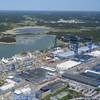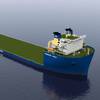Class society ABS has issued Approval In Principle (AIP) to a new liquefied natural gas (LNG) tank containment system and carrier design developed by Houston-based Ocean LNG Inc. The tank design consists of a cylindrical tank with spherical dished ends. The 180,000m3 carrier design features five of these large 36m diameter and 40m high cylinder tanks each holding a volume of 36,000m3 of LNG.
Ocean LNG asserts that the design maximizes the void spaces in the ship’s hull yet still provides full access around the tank for inspections of both the insulation and tank structure. Compared to the traditional spherical LNG tank containment system, the Ocean LNG tank system is expected to increase cargo capacity within the same main hull dimensions by an estimated 25 percent compared to spherical LNG tank systems.
A key aspect of transporting LNG is the ability of the containment system to withstand dynamic sloshing loads of the LNG cargo when a tank is partially filled. Membrane systems are particularly sensitive to sloshing loads. The Ocean LNG proprietary tank design is fashioned according to IMO Type B independent tank design and based on the leak before failure principle. The tanks are designed to minimize filling restrictions due to sloshing effects. A detailed sloshing analysis of the tank and pump tower designs was recently been completed by ABS.
As part of its AIP process, ABS evaluated the overall tank and vessel design to include: containment system and structural strength feasibility, tank support system, midship section scantlings, stability analysis, hull form and speed calculations, and hydrodynamic analysis for an overall feasibility of the Ocean LNG carrier design.
The tank containment system was evaluated to the requirements of ABS Rules and the International Gas Code (IGC). In the Ocean LNG review process ABS referred to its Guidance Notes on Review and Approval of Novel Concepts. This document outlines a methodology for requesting classification of a novel design that may have no previous experience in the environment being proposed. Therefore, these concepts have such little precedent and may be so different from existing designs that guidance encompassed in class Rules may not be directly applicable.
“The marine and offshore industries frequently develop novel applications in response to industry and market demands,” commented Philip Rynn, Senior Staff Consultant, Engineering, ABS. Rynn certified the design principles of Ocean LNG’s tank containment system and carrier design. He explains the AIP process draws upon engineering, testing and risk assessments in order to determine if the concept provides acceptable levels of safety in line with current offshore and marine industry practice. “The methodology relies heavily on risk assessment techniques as a way to better understand and anticipate structural and operational issues related to the novel concept,” he added.
With the increased demand for natural gas, operators are continuously looking for efficient and safe ways for containing, transferring and transporting LNG. With over 50 years of experience classing LNG carriers, ABS has the distinction of having classed LNGs built with all types of accepted containment systems. And it continues to facilitate industry innovation by providing technical guidelines for new LNG containment concepts. This year ABS has won classification contracts for a rash of newbuilding LNG contracts bringing its current orderbook to 23 vessels
Subscribe for
Maritime Reporter E-News
Maritime Reporter E-News is the maritime industry's largest circulation and most authoritative ENews Service, delivered to your Email five times per week










